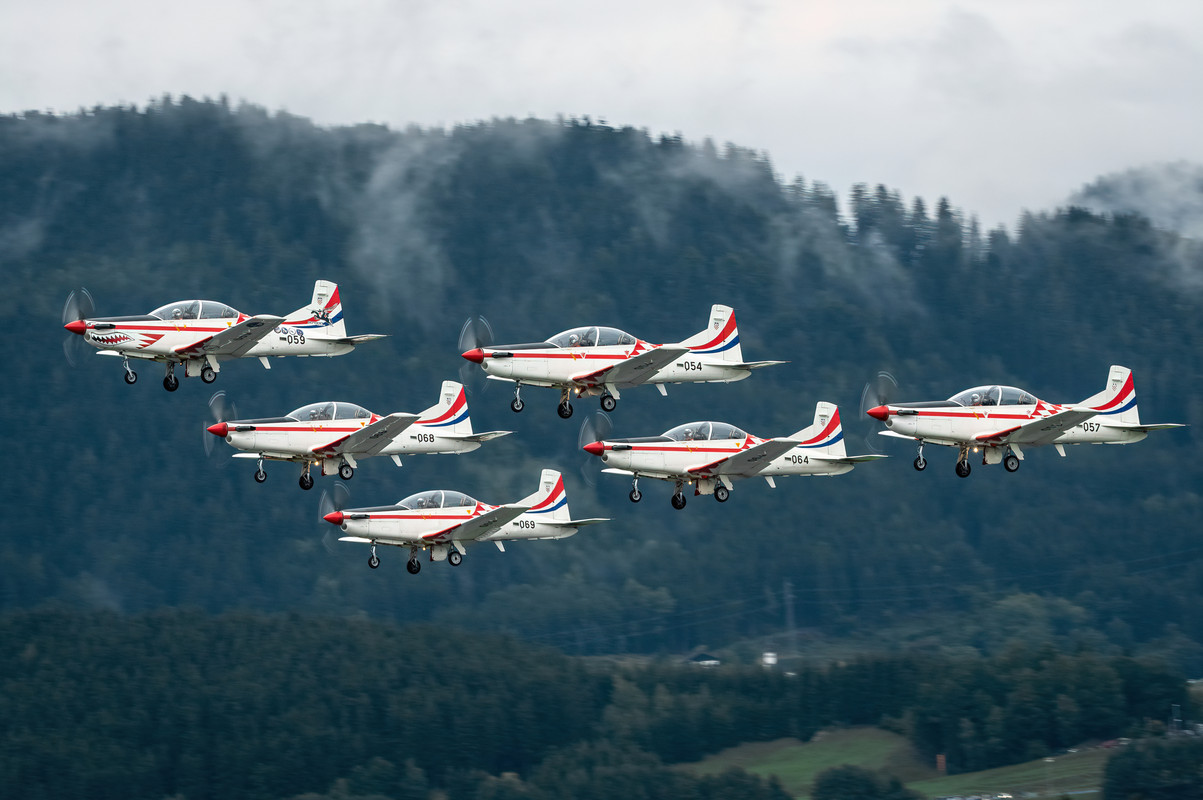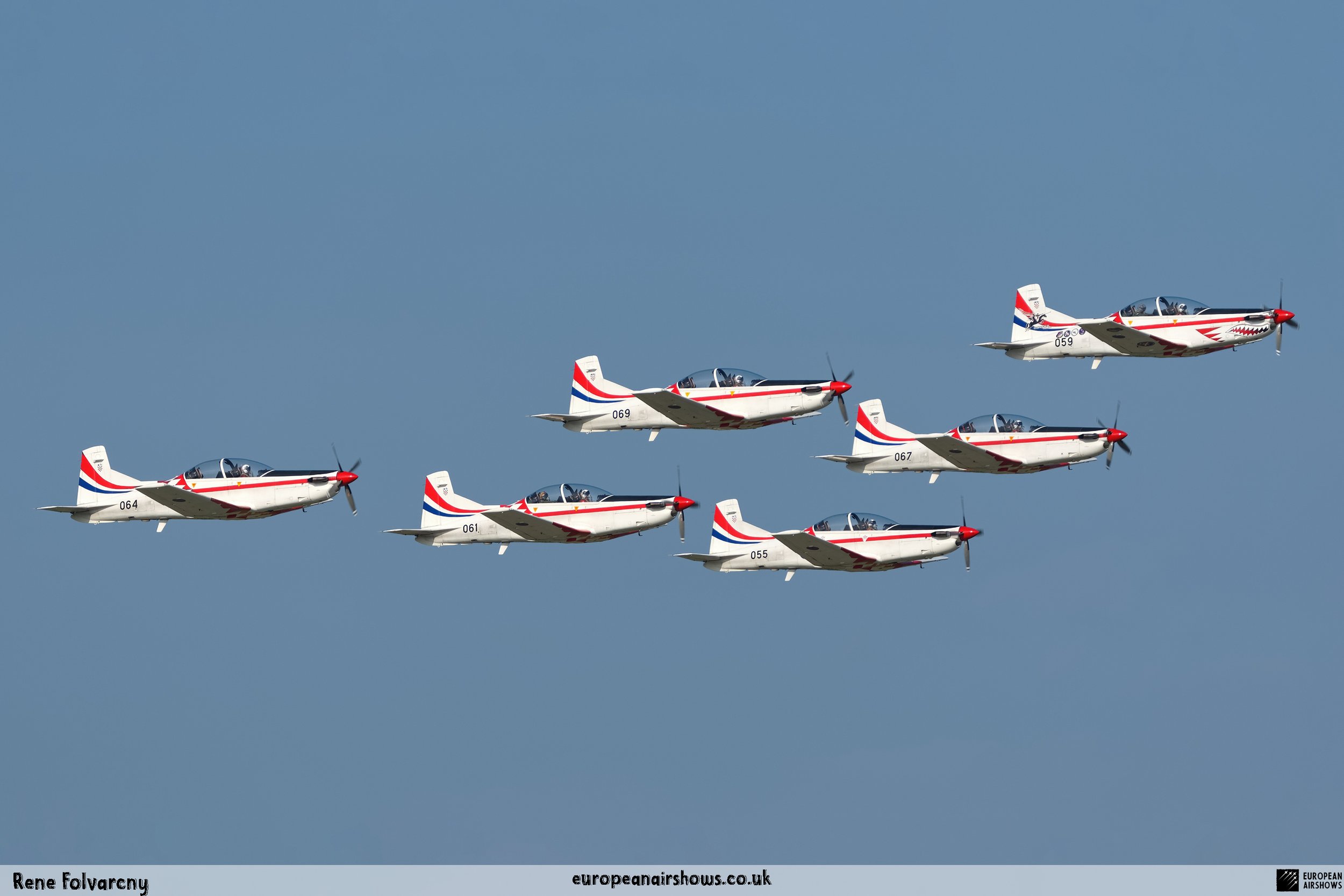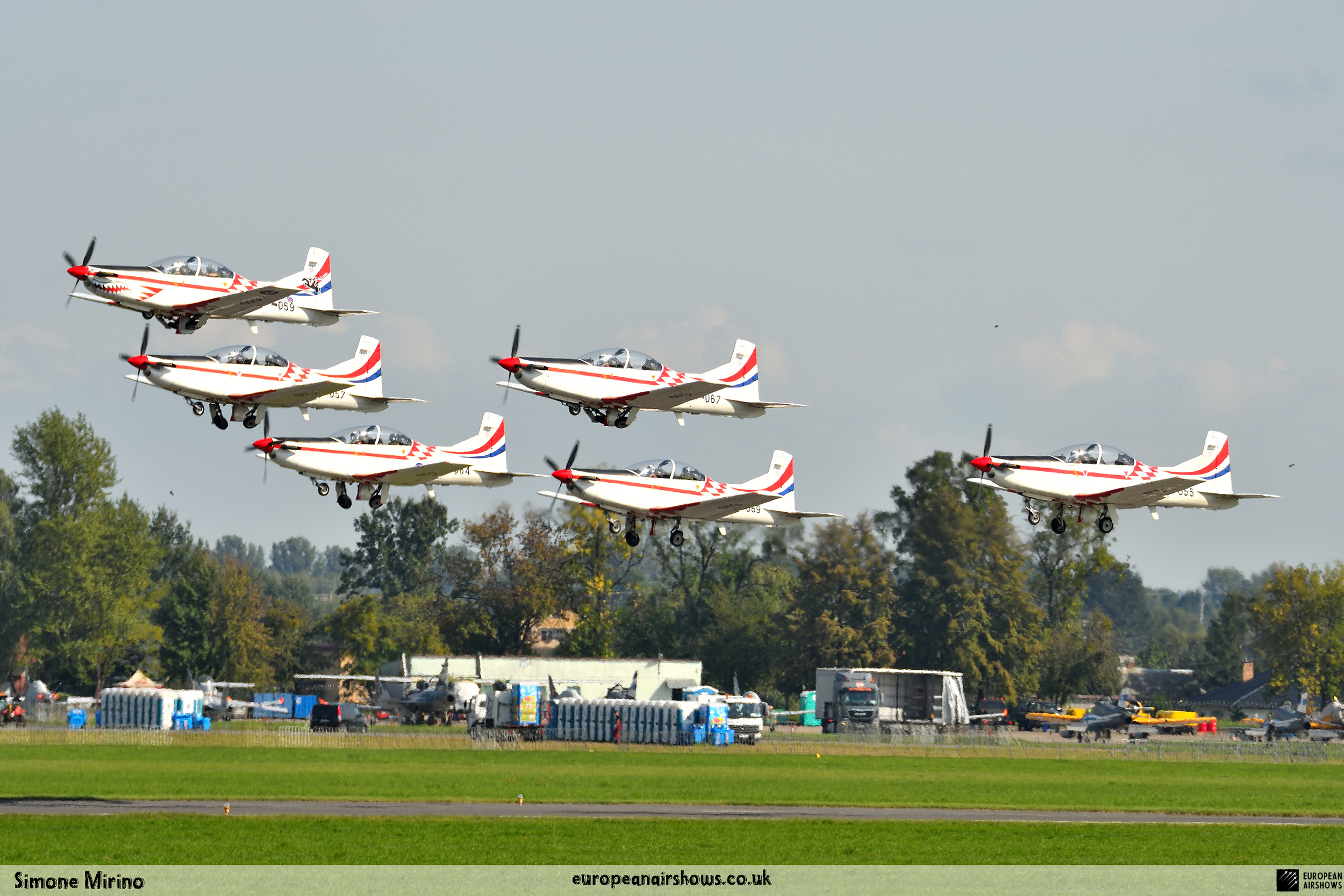
Krila Oluje
About the Team
The Wings of Storm (Krila Oluje) is not just an aerobatic team; it represents the pinnacle of aerial precision and teamwork in Croatia. Comprising six highly trained instructor pilots from the 93rd Military Airbase in Zemunik, the team has carved out a niche in the world of military aviation. Each pilot brings a wealth of experience and expertise, having undergone rigorous training that equips them to perform complex aerial maneuvers with impeccable timing and coordination. The aircraft they fly, the Pilatus PC-9M turboprop, is renowned for its agility and responsiveness, making it an ideal choice for aerobatic performances.
Among the notable figures in the team is Captain Diana Dobos, a trailblazer in the aviation community. Serving with the team from 2005 to 2007, she made history by becoming the third woman globally to fly in an aerobatic team. Her journey is an inspiring testament to breaking gender barriers in a field that has been predominantly male-oriented. Captain Dobos’s involvement not only highlights the team’s commitment to diversity but also serves as an encouragement for aspiring female aviators in Croatia and beyond.
The pilots of Krila Oluje engage in an extensive training regimen that emphasizes both individual skill and team cohesion. Their display routine, which lasts approximately 23 minutes, is a showcase of their ability to perform intricate maneuvers with breathtaking precision. Among these maneuvers are formation tailslides, where the aircraft momentarily fly backward, and formation spins, which require impeccable synchronization. The pilots maintain an astonishingly close formation, flying less than 2 meters apart while reaching speeds of up to 550 km/h. This level of proximity demands not only technical skill but also an acute awareness of each other’s movements, as any miscalculation could lead to serious consequences.
The G-loads experienced by the pilots during these displays range from -2.5 g to +6.5 g, placing immense physical and mental demands on them. To prepare for these challenges, the pilots undergo a rigorous physical fitness program and practice various scenarios that simulate the stresses of flight. Their dedication to excellence is evident in every performance, as they strive to push the boundaries of what is possible in aerobatics. Through their artistry in the sky, the Wings of Storm have become ambassadors of Croatian aviation, inspiring awe and admiration both at home and abroad.
Team Overview
Number of Aircraft
6
Established
2004
Based
93rd Military Air Base in Zemunik
Aircraft Type
Pilatus PC-9M
About the aircraft
The Pilatus PC-9M is a single-engine, low-wing tandem-seat turboprop trainer developed by Pilatus Aircraft in Switzerland. An evolution of the PC-7, it first flew in May 1984 and received certification in September 1985. The Royal Saudi Air Force placed the first production orders, with deliveries starting that same year. To date, over 250 units have been produced in five variants, serving military and civilian operators worldwide, including the Swiss, Croatian, and Royal Thai Air Forces.
While retaining the PC-7’s overall layout, the PC-9M features significant upgrades, including a larger cockpit with stepped ejection seats and a ventral airbrake. The program began in 1982, with initial aerodynamic tests conducted on the PC-7. The first prototype flew in May 1984, followed by a nearly production-ready second prototype in July. Although it lost the Royal Air Force trainer competition to the Short Tucano, the connections forged during the process led to successful orders, starting with Saudi Arabia.
Team History
The history of the Wings of Storm is a remarkable journey marked by passion, dedication, and a commitment to excellence in aerobatics. The team made its debut on July 22, 2004, during the opening ceremony of the European sailing championships in Zadar, where they performed with just four aircraft. This initial display was a significant milestone, laying the groundwork for what would become one of Croatia’s most celebrated aerobatic teams. The performance captivated audiences and sparked interest in the potential of the team, setting the stage for their future endeavors.
A pivotal moment in the team’s history occurred on August 5, 2005, when they participated in the celebration of the 10th anniversary of Operation Oluja, a critical military and police operation in Croatia. Their impressive aerial display during this event not only showcased their skills but also resonated deeply with the Croatian public, leading to the official adoption of the name “Krila Oluje,” which translates to “Wings of Storm.” This name embodies the spirit of resilience and courage that characterizes both the team and the nation.
As the team gained recognition, they expanded their fleet to enhance their capabilities. By the end of 2005, they added another aircraft, and in 2009, they welcomed yet another to their ranks. This expansion allowed them to perform more complex and dynamic routines, culminating in their first display as a six-ship formation on March 25, 2009. This achievement marked a new chapter in their history, showcasing their ability to execute intricate maneuvers with precision and flair.
However, the team faced a significant turning point on March 4, 2015, when all six pilots submitted requests to end their military service and leave the Air Force. This decision effectively disbanded the Wings of Storm just months before their tenth anniversary, as the pilots received an enticing offer from Qatar to fly the more advanced PC-21 aircraft. This unexpected turn of events left a void in the Croatian aerobatic community and raised questions about the future of the team.
Despite this setback, the legacy of the Wings of Storm did not end. In 2015, the team was reformed with new pilots who embraced the challenge of continuing the tradition of excellence established by their predecessors. The new members underwent extensive training to familiarize themselves with the routines and expectations of the team, ensuring that the spirit of Krila Oluje remained alive. Their debut performance at the Royal International Air Tattoo (RIAT) in 2016 was a resounding success, where they were awarded the prestigious “King Hussein Memorial Sword” for the best overall flying demonstration. This accolade was not only a testament to their skill but also a celebration of the team’s resilience and commitment to excellence.
The Wings of Storm continued to build on their success, earning recognition for precision flying at the Slovak International Air Fest (SIAF) in 2017. Their performances have continued to captivate audiences, reaffirming their status as one of the premier aerobatic teams in the world. Through their dedication to their craft and their ability to inspire, the Wings of Storm have solidified their place in the annals of Croatian aviation history, serving as a source of national pride and a beacon of excellence in the skies.
Did You Know?
- The Wings of Storm is Croatia’s premier aerobatic team, consisting of six skilled instructor pilots from the 93rd Military Airbase in Zemunik, who perform complex maneuvers using the agile Pilatus PC-9M turboprop aircraft.
- Captain Diana Dobos made history between 2005 and 2007 as the third woman in the world to fly in an aerobatic team, highlighting the team’s commitment to diversity and inspiring future female aviators.
- Krila Oluje’s display routines last approximately 23 minutes and feature intricate maneuvers such as formation tailslides and spins, with pilots flying in exceptionally close formations at speeds reaching up to 550 km/h.
- The team’s debut took place on July 22, 2004, at the European sailing championships in Zadar with just four aircraft, marking the beginning of what would become one of Croatia’s most celebrated aerobatic teams.
- In 2016, the reformed Wings of Storm earned the “King Hussein Memorial Sword” at the Royal International Air Tattoo, demonstrating their resilience and continued excellence despite previous challenges.












